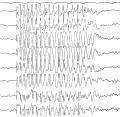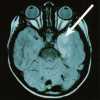
| Introduction | History | Diagnosis | Therapy | Art | Famous People |
? sitemap masthead |
German Epilepsie Museum Kork Oberdorfstraße 8, D-77694 Kehl-Kork, Germany open Sundays 2.00 - 5.00 p.m. or by arrangement email: info@epilepsiemuseum.de |
| Introduction |
| What is epilepsy? |
| Epileptic seizures |
| Types of epilepsy |
| Causes of epilepsy |
| Therapy |
| Consequences |
| History |
| The History of Epilepsy |
| The Disease with 1000 Names |
| Institutions for people with epilepsy |
| People with epilepsy during the Nazi regime |
| Diagnosis |
| ... in the Ancient World |
| modern Methods |
| Therapy |
| ... in the Ancient World |
| ... in the Middle Ages |
| ... from the Renaissance to the Present |
| Art |
| Votive tablets |
| Religious Art |
| Other works |
| Epilepsy Motifs in literature |
| Famous People |
| Introduction |
| Gallery |
| Note |

|
Diagnosis in the Ancient World (1/2)
The 'Holy Sickness', epilepsy, was diagnosed by ancient Greek, Roman and later by the Byzantine physicians whom they had influenced, mainly by observing the clinical symptoms, i.e. by observing the epileptic seizures. As no other diagnostic means then existed, the most important 'diagnostic instruments' for the physician of antiquity were exact observation, the careful recording of the patient's case history (mainly from information provided by the patient's relatives) and his own analytic thinking. |
Only in exceptional cases did other factors play a supporting role in the diagnosis: The physicians of antiquity knew, for instance, that the glistening wet surface of a turning potter's wheel would trigger an epileptic seizure in some people. In this way it was possible for them to objectify the disposition of some epilepsy patients to having seizures. We know now that seizures are triggered in such people as a result of their photosensibility. |


|
Diagnosis in the Ancient World (2/2)
Today, such susceptibility can be tested in an EEG laboratory using a stroboscope. Such seizures can be provoked by computer games, the television or the flashing lights in a disco. |
Of course, the ancient world also used dubious practices to make diagnoses: In the Roman era it was usual to give people suspected of having epilepsy a piece of jet to smell. If the person did not fall to the ground on smelling the stone, he was considered to be 'free of the falling sickness'. (This was for a time a common procedure when buying slaves.) The Greek physician Alexandros of Tralleis (525-605) suggested the following method to diagnose epilepsy: "Wash the head of the patient and burn a goat's horn under his nose and he will fall down." |



|
Modern Methods for diagnosing epilepsy (1/3)
Today, electroencephalography (a method of measuring brain wave patterns, often abbreviated to EEG) plays a decisive role in diagnosing epilepsy. |
Every nerve cell (neuron) is a highly complex form whose function is linked to electrical (and chemical) processes. With the help of an EEG, the electrical processese can be made visible in a very simplified form. A piece of EEG equipment is basically an instrument which receives and intensifies electrical potentials (voltage fluctuations) and transfers them to a recording instrument (which is now in many cases a computer). |



|
Modern Methods for diagnosing epilepsy (2/3)
The fluctuations of the electrical impulses can be measured outside the skull using pairs of electrodes (e.g. of silver chloride). Each pair of electrodes transmits a signal to the EEG, consisting of the difference of the voltage between the pair and showing the cumulative potential of thousands of neurons. These fluctuations vary within a range of less than a millionth of a volt. The electrodes are placed on the head of the patient following an internationally laid-down pattern and held in place with a rubber cap, or stuck to the scalp. Depending on the condition and head-size of the patient, 20, 40, or more electrodes can be used. |
Other EEG techniques use so-called electrode caps in which the electrodes are incorporated into the fabric of the cap. The cap is then pulled over the patient's head. Alternatively, individual electrodes are used which are fixed onto the patient's scalp. |


|
Modern Methods for diagnosing epilepsy (3/3)
The EEG of a patient with a cerebral disorder often looks different. |
Computer-Tomography (CT: a method for measuring differences in density in organic tissue using X-rays) is another technique used to diagnose epilepsy as is Magnetic Resonance Imaging (MRI: a diagnosis technique using strong magnetic fields). |





| About the museum | Access | Discovery of the Day | Library |
| How to react to a seizure |